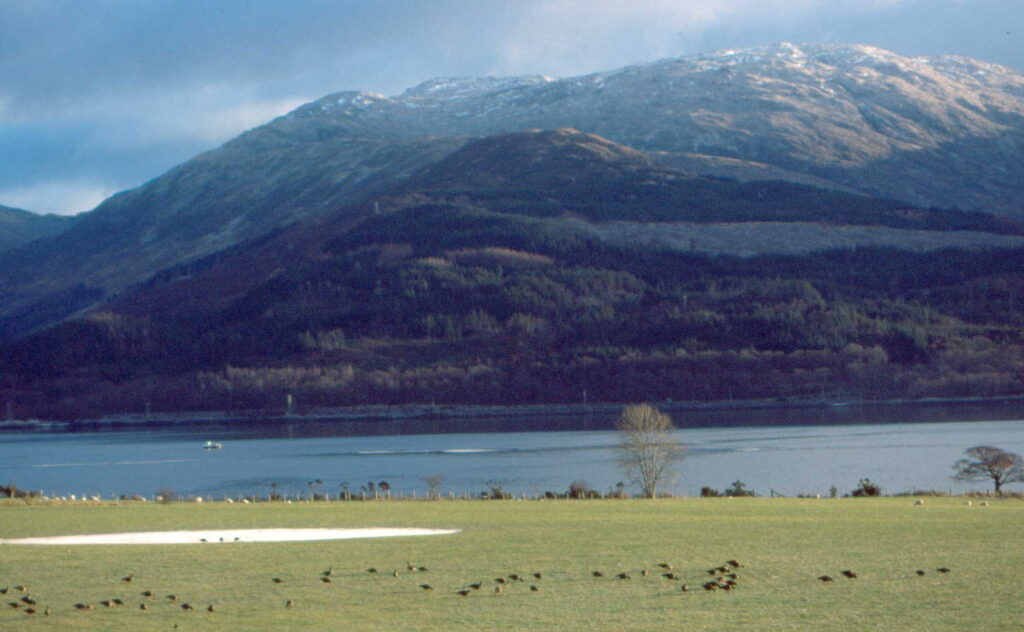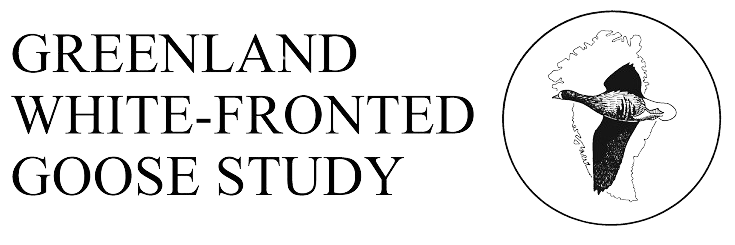
History
Almost nothing is known of this little flock or it history at this site. It was not mentioned by Harvie-Brown & Macpherson (1904), Berry (1939) or Baxter & RIntoul (1953), although Dr Bruce Campbell (pers. comm.) well remembered small numbers of White-fronted Geese there from his childhood days during the 1920s. A-W (1963) refers to 30-100 White-fronted Geese that “used to appear on the moss around the lower end of Loch Shiel, but at present their status is obscure”. R&O (1979) indicate an increase in numbers to perhaps 250 birds at the time of their review.
Status
Regional importance (R&O 48). One of the last Scottish flocks away from Islay that still regularly uses patterned oceanic raised bog vegetation and probably one of the very few to feed on bogs persistently through the winter by day. Numbers recently are considerably less than those reported by R&O (1979). However, despite their vulnerable position, and much destruction of mire vegetation through afforestation in the area, this flock seems to have maintained their numbers at 35-50 individuals since the early 1990s, the peak count showing very slow decline over many years rather than the more dramatic declines since the late 1990s seen in some neighbouring flocks.
Maximum winter counts:
Breeding success: No figure provided because of the small flock size and few data, on the bogs geese can be spectacularly difficult to age with confidence.
Feeding sites and habitat: Kentra (NM6570) and Claish Mosses (NM7168) are both used as feeding and roost sites, whilst the shores of Loch Shiel may also be used for a daytime refuge from disturbance, for foraging, preening and roosting. Claish Moss lies along the southern shore of Loch Shiel, while neighbouring Kentra Moss opens into Kentra Bay. They are representative of a highly oceanic blanket bog type found on the north-west coast of Scotland. These are two of the only three known ‘eccentric’ mires in Britain and show unusual and spectacular surface patterns (similar to types more commonly found in central Scandinavia) similar to raised bog. The surface patterning is especially important for the feeding geese, which exploit the soft substrate to extract the lower stems of Eriophorum angustifolium and the overwintering bulbils of Rhynchosproa alba that are common at the two sites. This flock is unique in frequenting the complex of the extremely large mire systems in the area, more or less throughout the entire winter. The flock has been frequently reported as feeding in two or more groups. The size and remoteness of these habitats makes accurate census difficult, and the possibility remains that numbers may be underestimated because of this factor, although this seems unlikely, since the geese will also feed away from the mire systems on farmland at times, and in some years this seems to assume considerable importance. However, this recent pattern is in contrast to R&Os (1979) statement that “no farmland feeding has been observed”, so this is presumably a very recent phenomenon. Reseeded grassland at Dalilea (NM732691) and rough pasture at Cliff (NM668695) are especially favoured, as is an old improved field at Newton of Ardtoe (NM648703) which directly abuts Kentra Moss. There have been other reports of the Greenland White-fronted Geese from Achnanellan (NM747679), Shielfoot (NM657707) and in flooded fields in Acharacle village.
Roosting sites: Birds feeding on Kentra Moss by day have been observed flying to Claish Moss at night, but it seems likely given the surface patterning that Kentra may also be a roost site as well. Extensive roost dropping piles indicatative of over night sites have been found on a large pool system at Claish (NM713679) and signs of extensive Eriophorum feeding have been found at NM717685. Given that birds may resort to the open water of Loch Shiel, this could also represent an alternative roost site on some occasions, although the open and exposed nature of the loch suggest this is a less likely option than the mire pool systems.
Habitat change: Although many areas of peatland around Loch Shiel have been drained in recent historical times, the main raised mire complexes of Kentra and Claish Mosses seem to have survived in an hydrologically intact state. An extensive area of bog outwith the boundaries of the Claish Moss National Nature Reserve was deep ploughed for commercial afforestation in 1983; while it is not known if the geese ever used this particular area for feeding, this loss of habitat through destruction undoubtedly reduced the area of potentially suitable habitat in the immediate area.
Aircraft disturbance: The site has been within a low-flying route and is regularly overflown by military aircraft. During one 30 minute period on November 15 1983, six jets passed over Kentra Moss. Now that the sites are safeguarded (see below), low flying jets may represent the single most important source of disturbance to this flock.
Hunting disturbance: Not known.
Agricultural disturbance: Not known, but not thought significant.
Site safeguard: The extensive boglands of Kentra Moss and Claish Moss are both protected as Claish Moss and Kentra Moss Special Area of Conservation (SAC); Kentra Moss is a Grade 2 NCR SSSI and a proposed Ramsar Site, first notified as SSSI in 1971 which includes intertidal flats, woodland and the patterned mire area. Claish Moss is a Grade 1 NCR SSSI, NNR and a Ramsar Site, as was as recognised as a UNESCO Biosphere Reserve in recognition as an outstanding example of an unmodified ecosystem. It was purchased by the then Nature Conservancy Council in 1978 when threatened with destruction by forestry and declared a National Nature Reserve. Loch Shiel is also an NCR SSSI and SPA.
SNH Natural Heritage Zones/Area: Western Seaboard.
Threats: Reclamation and afforestation of peatlands areas has slowed in recent years, but has removed considerable areas of suitable habitat from the range of this flock. Some suggestion of agricultural conflict with crofters was reported in the mid 1980s.
Linkages with other sites:
No marked birds have been reported from this site.
References
Baxter, E. & Rintoul, L.J. (1953) Birds of Scotland. Their History, Distribution, and Migration. Oliver & Boyd, Edinburgh
Berry, J. (1939) The status and distribution of wild geese and wild duck in Scotland. University Press, Cambridge.
Harvie-Brown, J. & Macpherson, H. (1904) A Fauna of the North West Highlands and Skye. David Douglas, Edinburgh.
